
The fool’s journey is almost complete. Card 21, the world, is the last card in the major arcana. He’s stepped from the symbols of resurrection in judgement to find one of the strangest of all the tarot images.
It feels like he’s stepped into a different universe.
Some might see world as a mother goddess like Gaia, Prithvi, Asherah, Isis or Danu but the card does not represent an individual. This is not the fool or a culmination of his achievements.
The world card shows the universality of the cosmos, a personification of infinity and eternal energy, neither fully understood and almost beyond words.
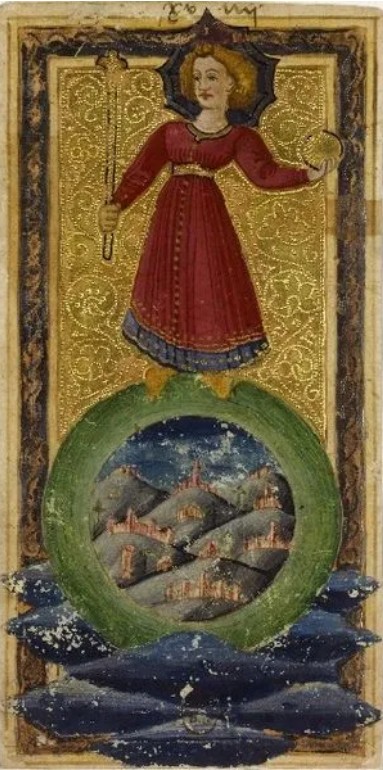
It aligns with the christian restoration of paradise, hebraic’s new jerusalem, moksha in hinduism and the buddhist enlightment of nirvana.
The fool has arrived at the final card and his last lesson.
Early cards showed the world contained within a circle. Planet earth was thought to be the centre of the universe, a belief which lasted until Nicolaus Copernicus first suggested the earth revolved around the sun in the early 16th century.
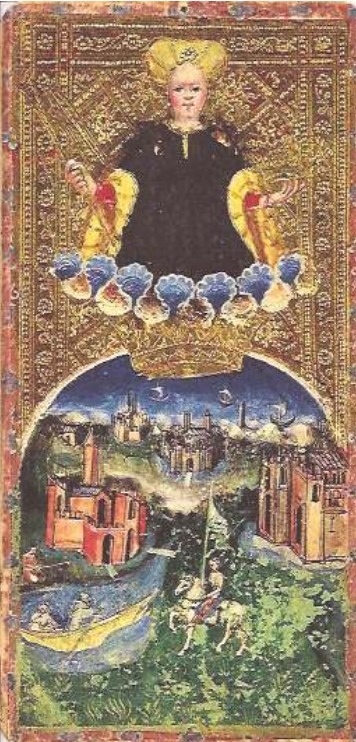
This was so different to established belief, it wasn’t widely accepted until the work of Galileo Galilei and Johannes Kepler in the 17th century.
The image of the universe as a series of concentric circles is similar to Dante’s 14th century vision of the nine circles of hell in his Inferno.
This text would have been popular among the educated aristocracy of 15th century Italy where the cards first appeared.
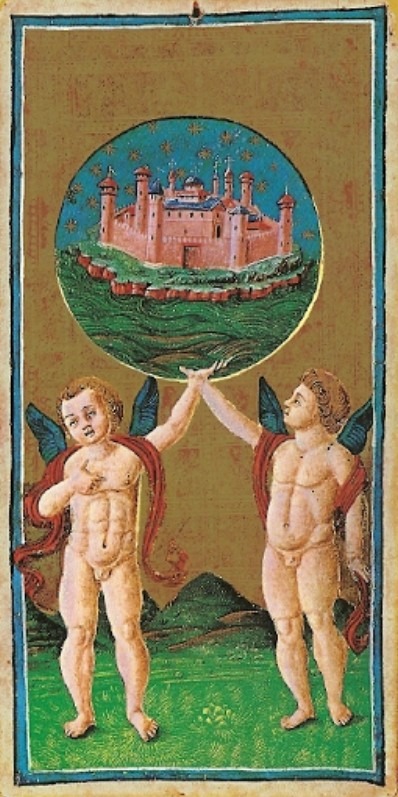
The Visconti Sforza world card shows a city inside a circle, as does the Budapest tarot, both from the 15th century.
At this time, judgement was the final card, preceded by the world.
In these decks, the world card represented the highest achievements, symbolised in the allegory of fame.
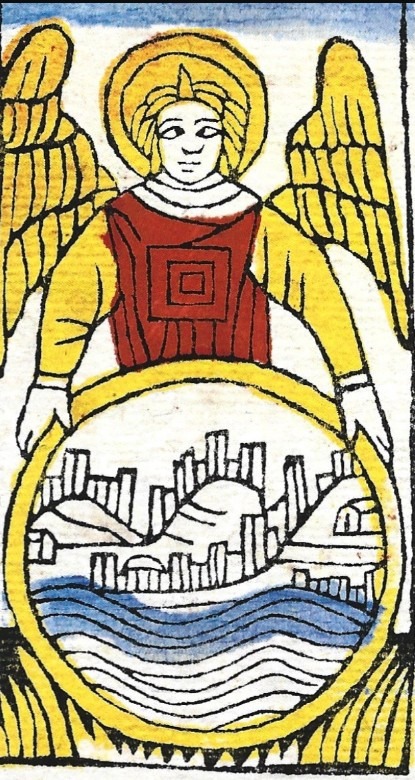
In the 15th century Rosenwald tarot, the angel above the world holds a sword and globe.
These were renaissance symbols of worldly power and strength.
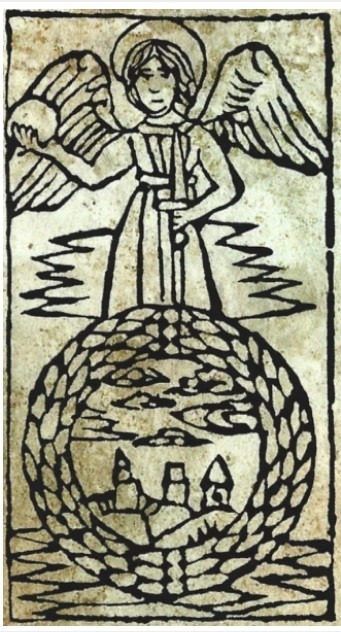
The Bolognese style Della Torre tarot from the 17th century shows a male figure standing on top of what looks like the world within a shield.
The figure is the god Hermes, later romanised as Mercury, with wings on his helmet and ankles.
He holds a caduceus and an orb, or globus cruciger, to reflect his roles in healing and trade.
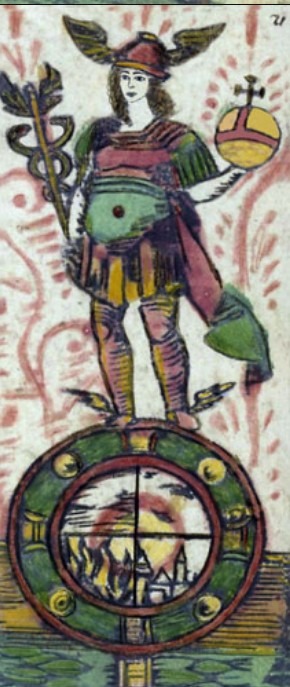
Depictions of the world card changed as the tarot arrived in France.
The Marseilles style Jacques Vievil and Jean Payen decks show the same corner figures as the wheel of fortune. These were the four Living Creatures of Ezekiel which have also been associated with the elements.
Top left, an angel (air), top right an eagle (water), bottom right a lion (fire) and bottom left the bull or ox (earth).
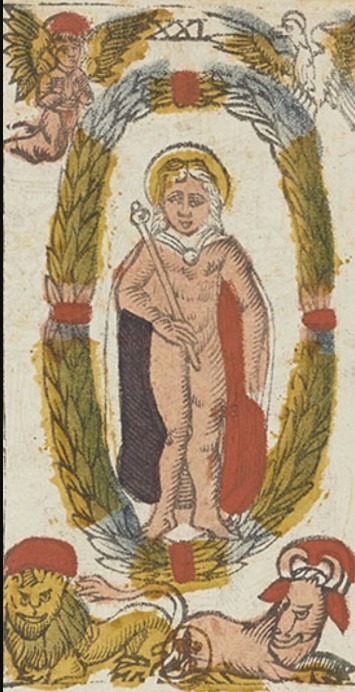
On the wheel of fortune these four figures are reading books as a symbol of knowledge.
In the world card, the books are absent.
The quest is fulfilled and there’s no longer any need for texts.
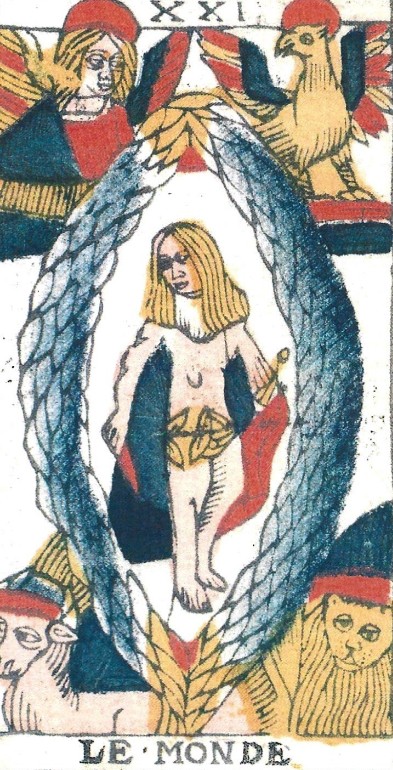
Early Marseilles-style designs show a woman inside a wreath, shaped like an oval mandorla (Italian for almond) also known as a vesica pisces (Latin for bladder fish).
The centre space created by two overlapping circles is the sign of a fish adopted by early christians. In sacred art, jesus was often shown inside this shape, with the four gospel disciples in each corner.
The centre figure changed depending on the tarot design.
The Jacques Vievil world card has a naked man with a halo.
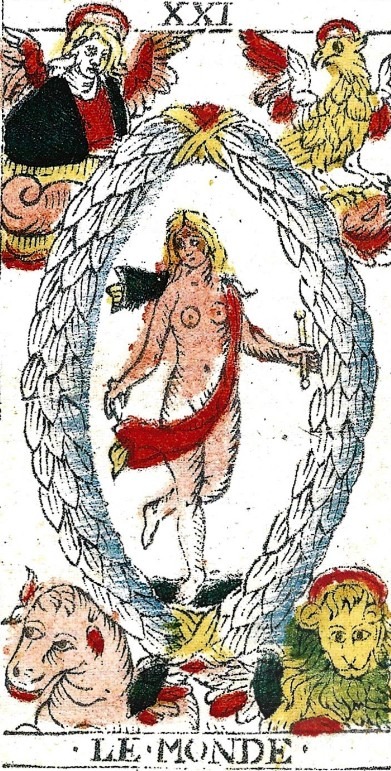
In the Jean Payen tarot, this figure has long hair and breasts but the genitals are hidden so their gender is ambiguous; the suggestion of hermaphrodite, named from the greek god Hermaphroditus.
The binary of gender has become unified.
In later Marseilles-style cards, the world figure is female, wearing a scarf or shawl across her body. The position of her legs is similar to the hanged man and she carries a wand in each hand.
The wands look like the one held by the magician. She now has a name – the soul of the world or anima mundi. Her life force is similar to that represented by the empress, the spark of life in all living things.
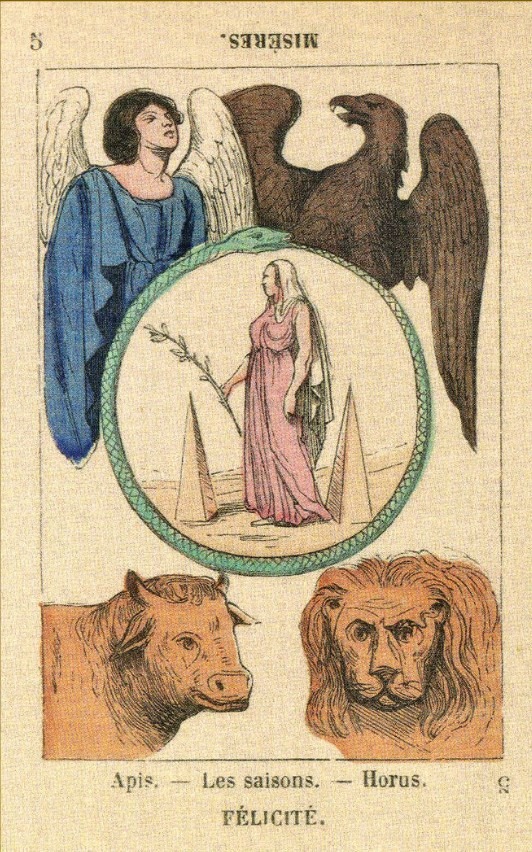
For the 18th century French occultists this was the source of creative energy manipulated in the magician card at the beginning of the major arcana.
The woman was a goddess, eternal and constantly moving.
Oswald Wirth coloured the wands red and blue, relating them to fire or energy and breath or air, both needing the other to survive.
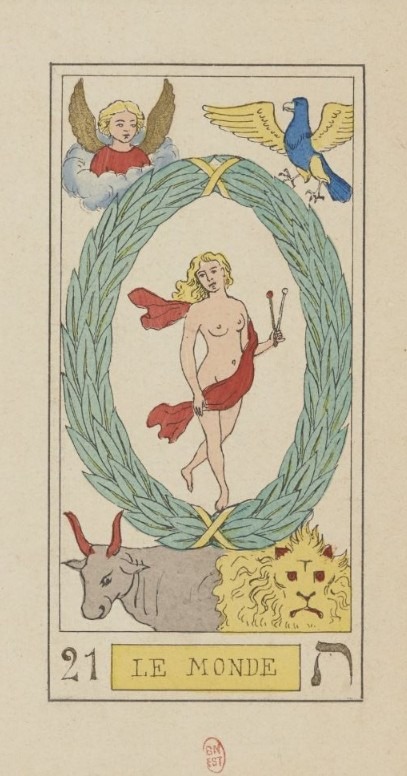
The esoteric meaning of the card related to spiritual achievement and harmony. The journey into the self was complete. Outer and inner selves combined. It also indicated the beginning of a new phase of life.
The Waite/Coleman Smith world contains similar designs and interpretations.
The fool sees the world figure suspended, like the moon or stars.
He can see but not reach or touch.
The position of the legs mirrors those of the hanged man while also suggesting temperance and star who had one foot on land and the other in water.
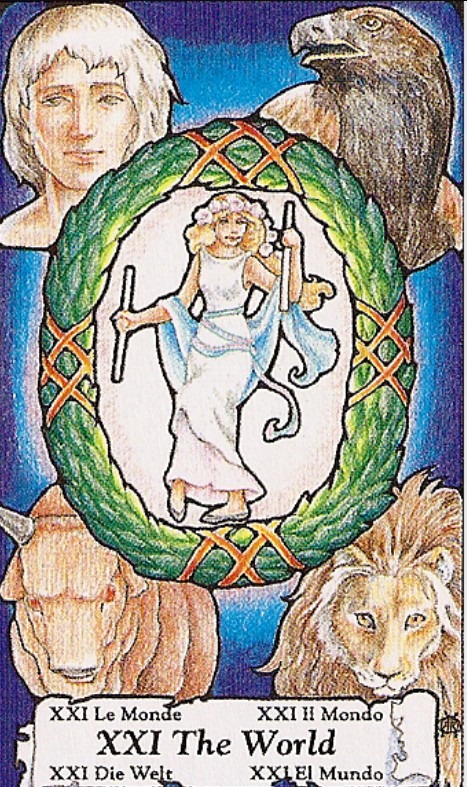
The flowing scarf is purple, associated with leadership and divinity. The suggestion of gender ambiguity has been retained. The world contains the possibilities of both. A union of both feminine and masculine energies.
A double topped wand is held in each hand. The magician held a single wand, and it appeared on the chariot where only the top half could be seen.
Wands are traditionally seen as conduits of power. It’s been suggested the ends represent the cone-shaped pineal gland seen on the tree behind the empress.
Wands were also believed to create connections between material and immaterial worlds. The top and bottom of the wand an indication of inner and outer awareness. Whereas the magician held his wand up to the sky, in the world card, each wand is balanced, a symbol of integration.
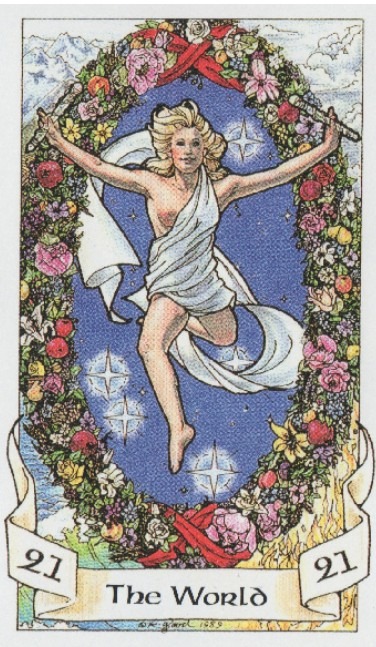
Another similarity with the magician is the red ribbons on the wreath, tied in the shape of the lemniscate over the magician‘s head, a mark of the eternal creative energy of the universe.
In the corners are the four creatures seen on the wheel of fortune; an eagle, bull, angel and a lion. On the world card they no longer have books open in front of them because knowledge has been made manifest. The creative energy manipulated by the magician has become fully integrated with the mysticism of the high priestess.
In the chariot, demonstrating material achievement through the power of the will, only one end of the wand was seen. The chariot indicated there’s still work to be done, the purpose of the following cards.

The wheel of fortune, at the half-way point, showed life can feel beyond individual control whereas the world shows a balance has finally been achieved.
The fool is full of awe.
He knows he has reached the end of this particular walk through the tarot.
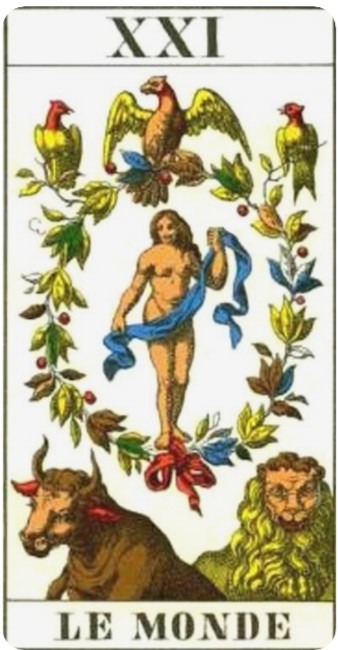
His understanding of the conscious world is complete.
During the journey he’s experienced a dissolution of ego, revealing the inner layers of himself.
The dissolution began with death on line two and the fool experienced an ecstatic awareness of an ego-free existence in the star, but this revelation was only temporary.

The world represents a more permanent mergence of inner and outer. The dancer is within a circle, which represents wholeness and infinity. The shape is reminiscent of the mythological cosmic egg from which the universe was said to have emerged.
The world completes the major arcana.
What does the card represent at this closing point of his journey?
The dancer is perpetual motion.
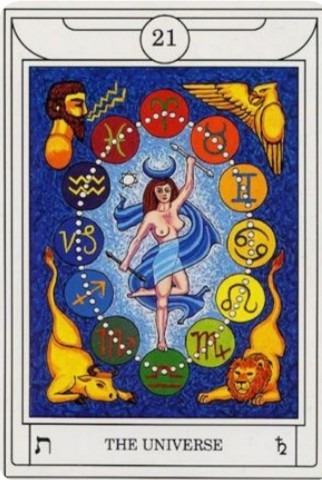
The embodiment of universal energy.
A unification of disparate parts.
A. E. Waite refers to the tarot cards as keys, each one can unlock a different aspect of the self.
The fool has met 21 of these keys.
The journey has been full of paradox.
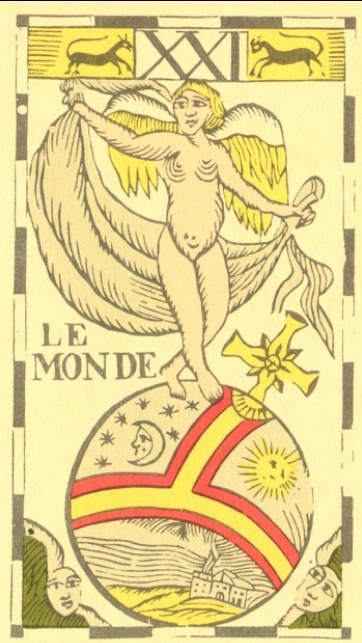
The fool’s internal layers of consciousness, unconscious and subconscious awareness have been revealed, as both separate and combined. He understands how everything in the conscious world is a binary construction, yet binary oppositions are also unified wholes and the tarot has shown the fool the potential of existence outside and beyond structured reality.
He’s examined himself. Come to terms with the events of his life.
Seen connections where previously he thought there were none.
The world card is an accumulation of all that has gone before.
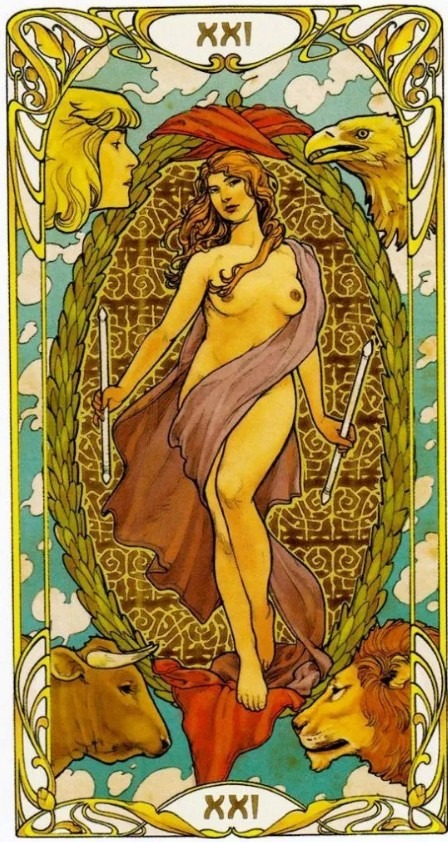
It signifies completion but the card is both an ending and a beginning.
The end of his tarot path and the beginning of what lies ahead, now he’s enriched through the integration of the different parts of his psyche.
The fool wants to leap into his unknown future but doesn’t want to leave the cards. He can see himself going back to the beginning and starting again, to re-meet the archetypes with his new levels of knowledge and understanding.
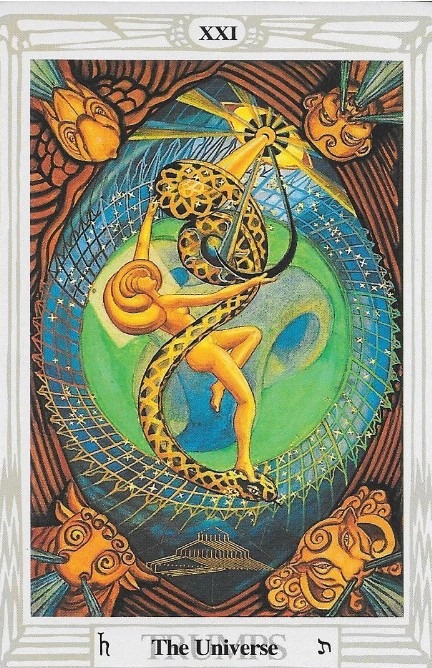
This is the purpose of the fool card as the number zero. It can appear anywhere in the numerical order, within or outside.
The world figure appears to be dancing. To dance is to move without arriving at a specific destination. When we dance, we often feel more alive. Energy flows through us bringing a sense of connection.
The fool is not a natural dancer but he understands the symbolism of the power of freedom through achievement.
It’s been a long journey.
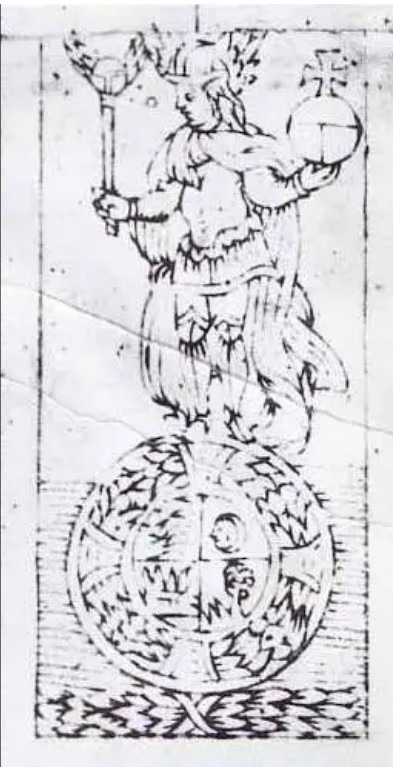
The learning doesn’t stop here but the card represents an ending of sorts. The fool has to return to the world he left, when he stood on the cliff edge, a dog barking at his feet in what could be seen as encouragement or warning.
If he’d known what lay ahead, would he have taken the next step?
The world card is affirmation.
It reinforces the idea of tarot as a journey.
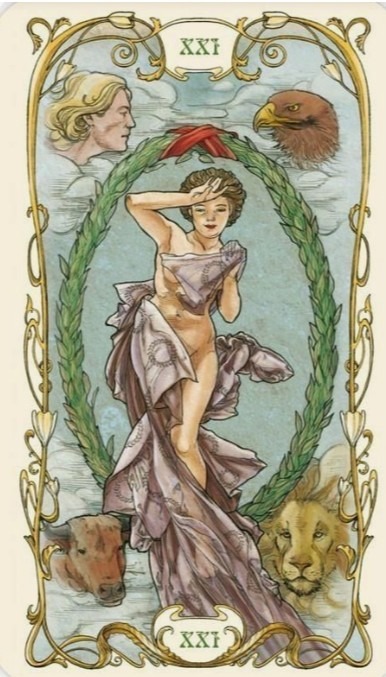
The fool has been introduced to the archetypes and learned to take responsibility for his own development, from both outer and inner perspectives.
He’s examined himself.
Understood the principles of cause and effect.
What he does can change the world, not necessarily the whole world but he can focus on his own little part of it to ensure what he does makes a positive difference.
At any time, the fool can return to the archetypes, revisit and ask new questions.
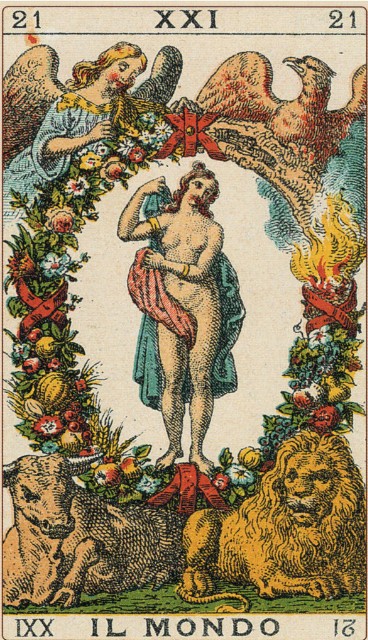
He’s already feeling drawn to the magician and high priestess he met at the beginning. So much of what they said passed him by, but he now feels in a better place to understand their messages.
It’s time to leave the world card and return to his own life.
There’s still 56 cards in the minor arcana, including the aces and court cards but they’ll wait for him to begin another path.
A different walk through the tarot.

images my own, copyright free from wikipedia commons or from https://pixabay.com/